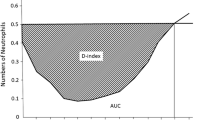Abstract
The D-index assesses neutropenia dynamics. Prolonged neutropenia is a major risk for invasive fungal infection (IFI); we hypothesized that D-index is predictive of IFI risk. We retrospectively reviewed 789 adults who underwent allogeneic hematopoietic transplant (HSCT) from 1/1/2005 to 9/30/2015. Medical records were reviewed from transplant (D0) through Day 100. The D-index was calculated as area over the neutrophil curve until engraftment. 714 patients were included for analysis. Sixteen (2%) developed probable (11) or proven (5) IFI. Median time to IFI was 40 days (range 8–98) after HSCT. Groups with and without IFI did not differ significantly in duration of mild or profound neutropenia. Median D-index of those with IFI was 4293 days neutrophil/µl compared to 3590 days neutrophil/µl for those without IFI (P = 0.17). Patients who were neutropenic on D0 showed higher rates of IFI than those who were not (10/123 [8%] vs 6/591 [1%]; P < 0.001). Only 2% developed IFI, likely due to mold-active antifungal prophylaxis. The D-index was not significantly higher in those with IFI. Duration of profound neutropenia and neutropenia at D0 may be better markers for IFI among HSCT recipients during the first 30 and 100 days after transplant.




Similar content being viewed by others
References
Engels EA, Ellis CA, Supran SE, Schmid CH, Barza M, Schenkein DP, et al. Early infection in bone marrow transplantation: quantitative study of clinical factors that affect risk. Clin Infect Dis. 1999;28(2):256–66.
Ketterer N, Espinouse D, Chomarat M, Dumontet C, Moullet I, Rieux C, et al. Infections following peripheral blood progenitor cell transplantation for lymphoproliferative malignancies: etiology and potential risk factors. Am J Med. 1999;106(2):191–7.
Kolbe K, Domkin D, Derigs HG, Bhakdi S, Huber C, Aulitzky WE. Infectious complications during neutropenia subsequent to peripheral blood stem cell transplantation. Bone Marrow Transplant. 1997;19(2):143–7.
Offidani M, Corvatta L, Olivieri A, Rupoli S, Frayfer J, Mele A, et al. Infectious complications after autologous peripheral blood progenitor cell transplantation followed by G-CSF. Bone Marrow Transplant. 1999;24(10):1079–87.
Saavedra S, Jarque I, Sanz GF, Moscardo F, Jimenez C, Martin G, et al. Infectious complications in patients undergoing unrelated donor bone marrow transplantation: experience from a single institution. Clin Microbiol Infect. 2002;8(11):725–33.
Portugal RD, Garnica M, Nucci M. Index to predict invasive mold infection in high-risk neutropenic patients based on the area over the neutrophil curve. J Clin Oncol. 2009;27(23):3849–54.
Cornillet A, Camus C, Nimubona S, Gandemer V, Tattevin P, Belleguic C, et al. Comparison of epidemiological, clinical, and biological features of invasive aspergillosis in neutropenic and nonneutropenic patients: a 6-year survey. Clin Infect Dis. 2006;43(5):577–84.
Marr KA, Carter RA, Boeckh M, Martin P, Corey L. Invasive aspergillosis in allogeneic stem cell transplant recipients: changes in epidemiology and risk factors. Blood. 2002;100(13):4358–66.
Nucci M, Anaissie EJ, Queiroz-Telles F, Martins CA, Trabasso P, Solza C, et al. Outcome predictors of 84 patients with hematologic malignancies and Fusarium infection. Cancer. 2003;98(2):315–9.
De Pauw B, Walsh TJ, Donnelly JP, Stevens DA, Edwards JE, Calandra T, et al. Revised definitions of invasive fungal disease from the European Organization for Research and Treatment of Cancer/Invasive Fungal Infections Cooperative Group and the National Institute of Allergy and Infectious Diseases Mycoses Study Group (EORTC/MSG) Consensus Group. Clin Infect Dis. 2008;46(12):1813–21.
Kimura S, Oshima K, Sato K, Sato M, Terasako K, Nakasone H, et al. Retrospective evaluation of the area over the neutrophil curve index to predict early infection in hematopoietic stem cell transplantation recipients. Biol Blood Marrow Transplant. 2010;16(10):1355–61.
Aoki J, Tsubokura M, Kakihana K, Oshikawa G, Kobayashi T, Doki N, et al. The predictive value for pulmonary infection by area over the neutrophil curve (D-index) in patients who underwent reduced intensity hematopoietic stem cell transplantation. Pathol Oncol Res. 2014;20(4):879–83.
Kimura S, Wada H, Ishihara Y, Kawamura K, Sakamoto K, Yamasaki R, et al. D-index dose not predict the development of pulmonary infection in acute myeloid leukemia patients undergoing consolidation chemotherapy with high-dose cytarabine. Hematology. 2014;19(2):107–12.
Kontoyiannis DP, Marr KA, Park BJ, Alexander BD, Anaissie EJ, Walsh TJ, et al. Prospective surveillance for invasive fungal infections in hematopoietic stem cell transplant recipients, 2001–2006: overview of the Transplant-Associated Infection Surveillance Network (TRANSNET) Database. Clin Infect Dis. 2010;50(8):1091–100.
Funding
This work was supported by the Mayo Clinic Small Grants Award [FP85701].
Author information
Authors and Affiliations
Corresponding authors
Ethics declarations
Conflict of interest
The authors report no conflict of interest.
Additional information
Publisher's Note
Springer Nature remains neutral with regard to jurisdictional claims in published maps and institutional affiliations.
About this article
Cite this article
Abad, C.L.R., Lahr, B., O’Horo, J.C. et al. The D-index is not correlated with invasive fungal infection during the early-post engraftment phase among allogeneic hematopoietic stem cell transplant recipients. Int J Hematol 111, 293–302 (2020). https://doi.org/10.1007/s12185-019-02776-x
Received:
Revised:
Accepted:
Published:
Issue Date:
DOI: https://doi.org/10.1007/s12185-019-02776-x




